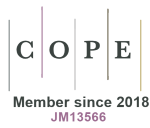ANTHROPOCENE: the “health” of the global village and the black swan
DOI:
https://doi.org/10.33393/gcnd.2022.2368Keywords:
Anthropocene, Communicable diseases, Globalization, HealthAbstract
Over the past three centuries, the effects of humans on the global environment have increased. It seems appropriate to assign the term “Anthropocene” to the current geological epoch, which is in many ways dominated by humans. The Anthropocene can be said to have begun in the latter part of the 18th century, when analyses of air trapped in polar ice showed the beginning of the rise in global concentrations of carbon dioxide and methane. This date also coincides with the design of the steam engine by James Watt in 1784. In particular, the 21st century witnessed an unforeseen but predictable resurgence of infectious diseases, not least the COVID-19 pandemic, which had a devastating impact on lives and livelihoods worldwide. The 2003 severe acute respiratory syndrome coronavirus outbreak, the 2009 swine flu pandemic, the 2012 Middle East respiratory syndrome coronavirus outbreak, and the 2013-2016 Ebola virus outbreak in West Africa all caused significant morbidity and mortality as they spread through the global village across borders to infect people in multiple countries. In the last 70 years, the speed at which human habits have changed through technological, demographic and climatic changes is unprecedented: airline flights have doubled since 2000, more people live in urban than rural areas since 2007, climate change poses a growing threat to society, and humans have stopped following the high road shown by nature with proper nutrition and regular exercise. In this review, we consider the extent to which these recent global changes have increased the risk of infectious disease outbreaks, even though improved sanitation and access to health care have led to significant progress worldwide.
References
- Lewis S, Maslin M, Il pianeta umano. Come abbiamo creato l'Antropocene. Trad. Simonetta Frediani. Einaudi, Le Scienze. 2020;19.
- Elhacham E, Ben-Uri L, Grozovski J, Bar-On YM, Milo R. Global human-made mass exceeds all living biomass. Nature. 2020;588(7838):442-444. https://doi.org/10.1038/s41586-020-3010-5PMID:33299177 DOI: https://doi.org/10.1038/s41586-020-3010-5
- Greene WC. A history of AIDS: looking back to see ahead. Eur J Immunol. 2007;37(S1)(suppl 1):S94-S102. https://doi.org/10.1002/eji.200737441 PMID:17972351 DOI: https://doi.org/10.1002/eji.200737441
- Maeda K. [Globalization and zoonosis]. Nihon Rinsho. 2016 Dec;74(12):1948-1955. Japanese. PMID: 30550648.
- Raafat N, Blacksell SD, Maude RJ. A review of dengue diagnostics and implications for surveillance and control. Trans R Soc Trop Med Hyg. 2019;113(11):653-660. PMID:31365115 https://doi.org/10.1093/trstmh/trz068 PMID:31365115 DOI: https://doi.org/10.1093/trstmh/trz068
- Chao C, Leone JL, Vigliano CA. Chagas disease: historic perspective. Biochim Biophys Acta Mol Basis Dis. 2020;1866(5):165689. PMID:32001300 https://doi.org/10.1016/j.bbadis.2020.165689 PMID:32001300 DOI: https://doi.org/10.1016/j.bbadis.2020.165689
- Jacob ST, Crozier I, Fischer WA II, et al. Ebola virus disease. Nat Rev Dis Primers. 2020;6(1):13. PMID:32080199 https://doi.org/10.1038/s41572-020-0147-3 PMID:32080199 DOI: https://doi.org/10.1038/s41572-020-0147-3
- Rossati A, Bargiacchi O, Kroumova V, Zaramella M, Caputo A, Garavelli PL. Climate, environment and transmission of malaria. Infez Med. 2016;24(2):93-104. PMID:27367318 PMID:27367318
- Bloom BR, Atun R, Cohen T, et al. Tuberculosis. In: Holmes KK, Bertozzi S, Bloom BR, Jha P, editors. Major Infectious Diseases. 3rd ed. Washington (DC): The International Bank for Reconstruction and Development / The World Bank; 2017 Nov 3. Chapter 11. PMID: 30212088.
- Zietz BP, Dunkelberg H. The history of the plague and the research on the causative agent Yersinia pestis. Int J Hyg Environ Health. 2004;207(2):165-178. PMID:15031959 https://doi.org/10.1078/1438-4639-00259 PMID:15031959 DOI: https://doi.org/10.1078/1438-4639-00259
- Leggett HC, Brown SP, Reece SE. War and peace: social interactions in infections. Philos Trans R Soc Lond B Biol Sci. 2014;369(1642):20130365. PMID:24686936 https://doi.org/10.1098/rstb.2013.0365 PMID:24686936 DOI: https://doi.org/10.1098/rstb.2013.0365
- Orata FD, Keim PS, Boucher Y. The 2010 cholera outbreak in Haiti: how science solved a controversy. PLoS Pathog. 2014;10(4):e1003967. PMID:24699938 https://doi.org/10.1371/journal.ppat.1003967 PMID:24699938 DOI: https://doi.org/10.1371/journal.ppat.1003967
- Drake TL, Devine A, Yeung S, Day NP, White LJ, Lubell Y. Dynamic Transmission Economic Evaluation of Infectious Disease Interventions in Low- and Middle-Income Countries: A Systematic Literature Review. Health Econ. 2016 Feb;25 Suppl 1:124-39. https://doi.org/10.1002/hec.3303. PMID: 26778620;. DOI: https://doi.org/10.1002/hec.3303
- Gil A, Ruiz-Lopez MD, Fernandez-Gonzalez M, Martinez de Victoria E. The FINUT healthy lifestyles guide: beyond the food pyramid. Adv Nutr. 2014;5(3):358S-367S. PMID:24829489 https://doi.org/10.3945/an.113.005637 PMID:24829489 DOI: https://doi.org/10.3945/an.113.005637
- Bortz WM II. The disuse syndrome. West J Med. 1984;141(5):691-694. PMID:6516349
- Blair SN, Kohl HW III, Paffenbarger RS Jr, Clark DG, Cooper KH, Gibbons LW. Physical fitness and all-cause mortality. A prospective study of healthy men and women. JAMA. 1989;262(17):2395-2401. https://doi.org/10.1001/jama.1989.03430170057028 PMID:2795824 DOI: https://doi.org/10.1001/jama.262.17.2395
- Christensen RAG, Arneja J, St Cyr K, Sturrock SL, Brooks JD. The association of estimated cardiorespiratory fitness with COVID-19 incidence and mortality: A cohort study. PLoS One. 2021;16(5):e0250508. PMID:33951071 https://doi.org/10.1371/journal.pone.0250508PMID:33951071 DOI: https://doi.org/10.1371/journal.pone.0250508
- International Food Policy Research Institute (IFPRI). From Promise to Impact: Ending Malnutrition by 2030. Global Nutrition Report 2016. Washington, D.C. Online https://www.ifpri.org/publication/global-nutrition-report-2016-promise-impact-ending-malnutrition-2030 (Accessed February 2022) DOI: https://doi.org/10.2499/9780896295841
- World Health Organization (WHO). The double burden of malnutrition. Policy brief. WHO; 2017.
- Abarca-Gómez L, Abdeen ZA, Hamid ZA, et al; NCD Risk Factor Collaboration (NCD-RisC). Worldwide trends in body-mass index, underweight, overweight, and obesity from 1975 to 2016: a pooled analysis of 2416 population-based measurement studies in 128·9 million children, adolescents, and adults. Lancet. 2017;390(10113):2627-2642. https://doi.org/10.1016/S0140-6736(17)32129-3 PMID:29029897 DOI: https://doi.org/10.1016/S0140-6736(17)32129-3
- Global Panel. The Cost of Malnutrition: Why Policy Action is Urgent. 2016. https://glopan.org/sites/default/files/pictures/CostOfMalnutrition.pdf (accessed December 2022).
- The Lancet. COVID-19: where do we go from here? Lancet. 2021;398(10318):2207. PMID:34922656 https://doi.org/10.1016/S0140-6736(21)02790-2 PMID:34922656 DOI: https://doi.org/10.1016/S0140-6736(21)02790-2
- Rae M. Omicron: a failure to act with a global focus will continue the proliferation of new variants of covid-19. BMJ. 2021;375(3095):n3095. https://doi.org/10.1136/bmj.n3095PMID:34916212 DOI: https://doi.org/10.1136/bmj.n3095
- Atwoli L, Baqui AH, Benfield T et al. Call for emergency action to limit global temperature increases, restore biodiversity, and protect health. BMJ 2021;374:n1734 https://doi.org/10.1136/bmj.n1734 PMID: 34483099 DOI: https://doi.org/10.1136/bmj.n1734











